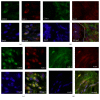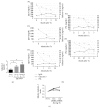High Expression of Galectin-3 in Patients with IgG4-Related Disease: A Proteomic Approach
- PMID: 28593065
- PMCID: PMC5448067
- DOI: 10.1155/2017/9312142
High Expression of Galectin-3 in Patients with IgG4-Related Disease: A Proteomic Approach
Abstract
Objectives: Immunoglobulin G4-related disease (IgG4-RD) is a multiorgan condition manifesting itself in different forms. This study aimed to investigate protein expression profiles and to find the possible biomarker for IgG4-RD by liquid chromatography mass spectrometry (LC-MS) using tissue sections in IgG4-RD patients.
Methods: Protein expression profiles in five IgG4-related pancreatitis and three normal pancreatic samples were compared using LC-MS and were validated by quantitative real-time PCR (qRT-PCR), immunoblotting, and immunohistochemistry. ELISA was employed in the serum of 20 patients with systemic IgG4-RD before and during steroid treatment.
Results: LC-MS indicated that the levels of 17 proteins were significantly higher and 12 others were significantly lower in IgG4-related pancreatitis patients compared to controls. Among these proteins, galectin-3 levels were 13-fold higher in IgG4-related pancreatitis (P < 0.01). These results were confirmed by immunoblotting and qRT-PCR. The average number of galectin-3 + cells in various organs of IgG4-RD patients, including salivary glands, lungs, and lymph nodes, was higher than in controls. Galectin-3 was detectable in macrophages, dendritic cells, and stromal myofibroblast-like cells, but not in lymphocytes by immunofluorescence staining. Serum galectin-3 levels were higher in patients with IgG4-RD compared with healthy donors and remained high during steroid therapy.
Conclusion: Galectin-3 was overexpressed in IgG4-RD and the levels were indirectly related to clinical activity.
Figures




Similar articles
-
Identification of galectin-3 as an autoantigen in patients with IgG4-related disease.J Allergy Clin Immunol. 2019 Feb;143(2):736-745.e6. doi: 10.1016/j.jaci.2018.05.011. Epub 2018 May 29. J Allergy Clin Immunol. 2019. PMID: 29852256 Free PMC article.
-
Proteomic analyses of plasma-derived exosomes in immunoglobulin (Ig) G4-related disease and their potential roles in B cell differentiation and tissue damage.J Autoimmun. 2021 Aug;122:102650. doi: 10.1016/j.jaut.2021.102650. Epub 2021 Jun 6. J Autoimmun. 2021. PMID: 34107438
-
Serum checkpoint molecules in patients with IgG4-related disease (IgG4-RD).Arthritis Res Ther. 2021 May 24;23(1):148. doi: 10.1186/s13075-021-02527-6. Arthritis Res Ther. 2021. PMID: 34030721 Free PMC article.
-
Pathogenesis of IgG4-related disease. Comparison with Sjögren's syndrome.Mod Rheumatol. 2020 Jan;30(1):7-16. doi: 10.1080/14397595.2019.1650694. Epub 2019 Aug 19. Mod Rheumatol. 2020. PMID: 31425659 Review.
-
Imaging features of immunoglobulin G4-related disease.J Med Imaging Radiat Oncol. 2016 Dec;60(6):707-713. doi: 10.1111/1754-9485.12511. Epub 2016 Aug 26. J Med Imaging Radiat Oncol. 2016. PMID: 27562417 Review.
Cited by
-
The Cellular and Molecular Bases of Allergy, Inflammation and Tissue Fibrosis in Patients with IgG4-related Disease.Int J Mol Sci. 2020 Jul 18;21(14):5082. doi: 10.3390/ijms21145082. Int J Mol Sci. 2020. PMID: 32708432 Free PMC article. Review.
-
IgG4 autoantibodies and autoantigens in the context of IgG4-autoimmune disease and IgG4-related disease.Front Immunol. 2024 Feb 16;15:1272084. doi: 10.3389/fimmu.2024.1272084. eCollection 2024. Front Immunol. 2024. PMID: 38433835 Free PMC article. Review.
-
Thrombospondin-1 induces CD8+ T cell exhaustion and immune suppression within the tumor microenvironment of ovarian cancer.J Ovarian Res. 2025 May 10;18(1):99. doi: 10.1186/s13048-025-01668-5. J Ovarian Res. 2025. PMID: 40349060 Free PMC article.
-
The spectrum of B cells in the pathogenesis, diagnosis and therapeutic applications of immunoglobulin G4-related disease.Clin Transl Immunology. 2023 Nov 28;12(12):e1477. doi: 10.1002/cti2.1477. eCollection 2023. Clin Transl Immunology. 2023. PMID: 38034079 Free PMC article. Review.
-
Increased Levels of Galectin-3 in Critical COVID-19.Int J Mol Sci. 2023 Oct 31;24(21):15833. doi: 10.3390/ijms242115833. Int J Mol Sci. 2023. PMID: 37958814 Free PMC article.
References
-
- Punnonen J., Aversa G., Cocks B. G., et al. Interleukin 13 induces interleukin 4-independent IgG4 and IgE synthesis and CD23 expression by human B cells. Proceedings of the National Academy of Sciences of the United States of America. 1993;90(8):3730–3734. doi: 10.1073/pnas.90.8.3730. - DOI - PMC - PubMed
LinkOut - more resources
Full Text Sources
Other Literature Sources
Miscellaneous

